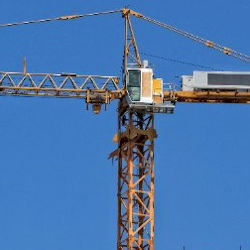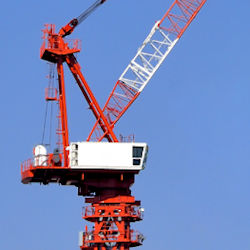Crane Types
Tower Cranes
Tower cranes have lifting structures that use a vertical mast or tower to support a working boom (jib) in an elevated position. Loads are suspended from the working boom. While the working boom may be of the fixed type (horizontal or angled) or have luffing (raising or lowering the boom) capability, it can always rotate to swing loads, either by rotating on the top of the tower (top slewing) or by the rotation of the tower (bottom slewing). The tower base may be fixed in one location or ballasted and moveable between locations.
Tower cranes include:
- Hammerhead Tower Cranes - those with a fixed jib (hammerhead boom). They are the most common type used.
- Self-Climbing Tower Cranes - as a building outgrows the fixed crane tower, a new piece of tower slides upwards through the center of the tower and adds itself to the top of the crane. The crane will continue to grow vertically.
- Derrick Tower Cranes - those designed to operate atop roofs or fit into small spaces. They are commonly found on ships or at docking facilities.
- Luffing Tower Cranes - those with a luffing boom that can be recognized by its diagonal arm coming out of the tower. If they are more than 100 meters high, they must be tied (tethered) to a building structure.
- Self-erecting Tower Cranes - those with towers that erect autonomously. The use of self-erecting tower cranes is limited to a height of 100 meters above ground level.
Knowledge Check Choose the best answer for the question.
1-3. Which type of tower crane is limited in height to less than 100 meters above ground level.
You forgot to answer the question!


